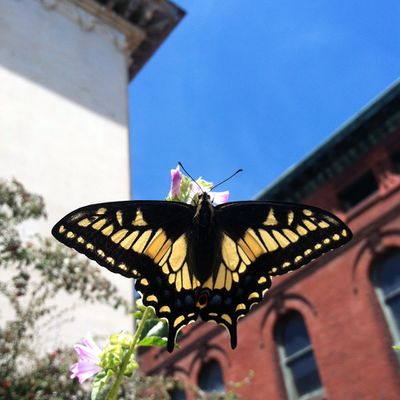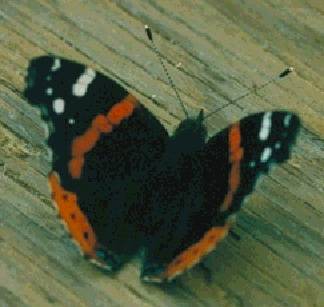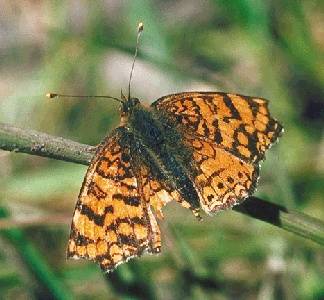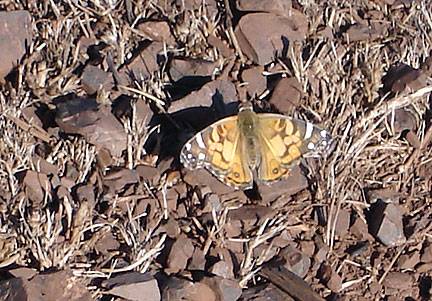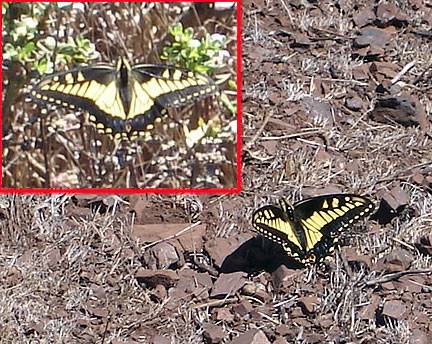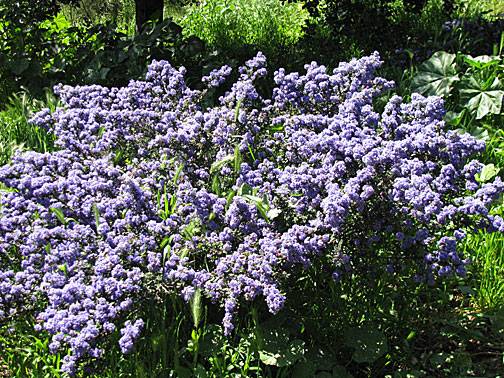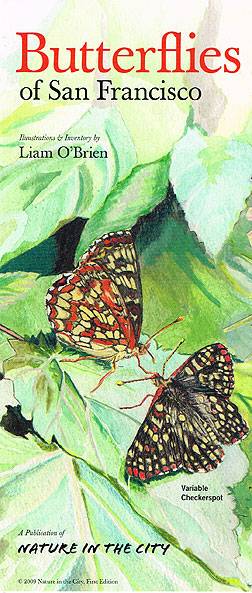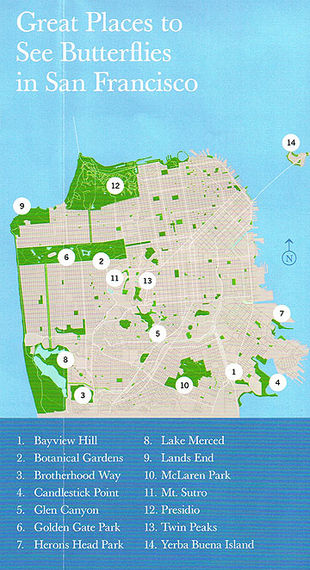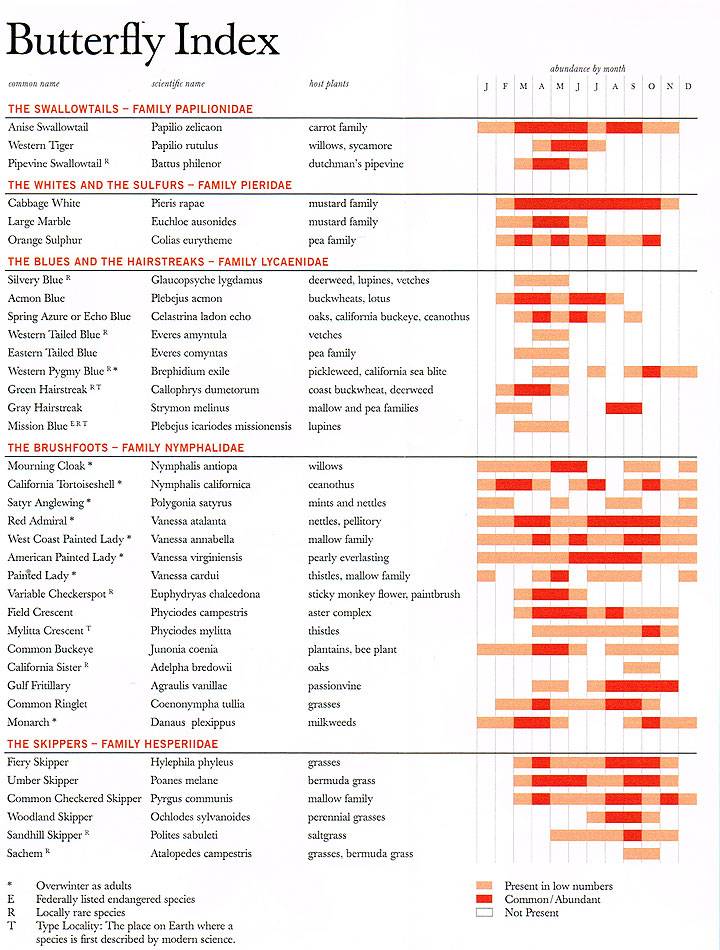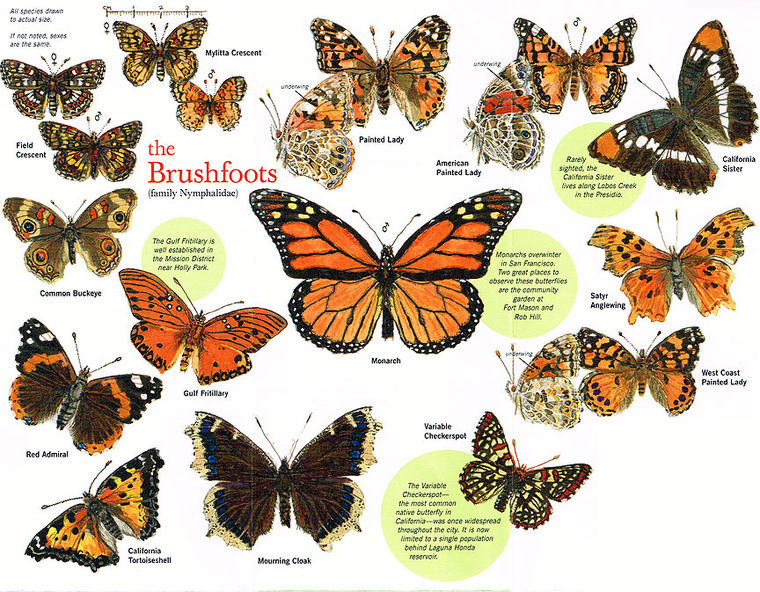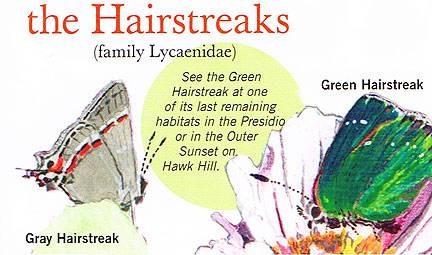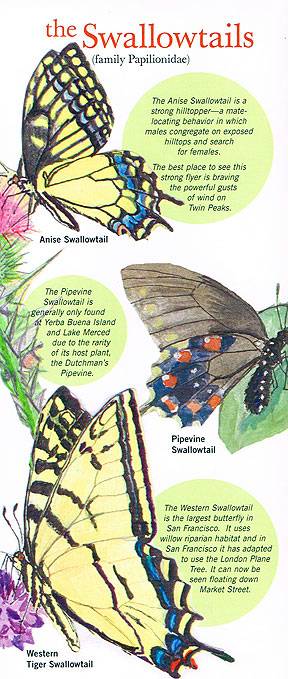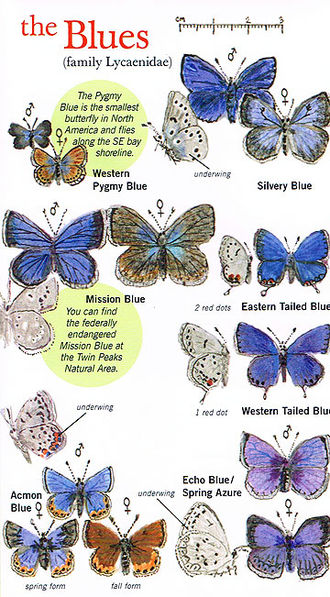Butterflies
Historical Essays
Part One by Pete Holloran
Part Two by Francis X. Williams
Anise Swallowtail at Pier 70 feeding on nectar of mallow flower, May 2015
Photo: LisaRuth Elliott
Red Admiral on Potrero Hill
Photo: Margo Bors
Mylitta Crescent spot in Glen Canyon.
Photo: Margo Bors
needs ID
Photo: Chris Carlsson
Anise Swallowtail on Twin Peaks, August 2007
Photo: Chris Carlsson
As early as the mid-1870s, entomologists and amateur naturalists in San Francisco began to lament the loss of native plant habitat and its effect on butterfly abundance and diversity. The fate of the Xerces blue butterfly, an endemic species of the dunes of San Francisco, was the most noticeable but hardly the only species in decline. In 1875 Hans Herman Behr, a local entomologist and early member of the California Academy of Sciences, was predicting its demise. "Glaucopsyche xerces is now extinct," he told a friend. "The locality where it used to be found is converted to building lots, and between German chickens and Irish hogs no insect can exist besides louse and flea" (Pyle 1976).
Its food plants, Lupinus arboreus (yellow bush lupine) and Lotus scoparius (deerweed), had declined dramatically as the city stretched out over the dunes. By the time of Behr's death in 1904, naturalists had relocated the Xerces blue in an isolated patch of dunes above Lobos Creek that still supported both food plants. By the early 1940s, however, the evidence was incontrovertible. The Xerces blue butterfly was extinct, the first documented extinction of a butterfly in North America.
In his later years, Behr began describing in print how the extensive habitat so favorable for certain butterflies had changed so remarkably in his lifetime. Behr was not the last to document the decline of butterfly diversity. In 1935, for example, M. Doudoroff of Stanford University noted that the Pheres blue butterfly was, up until 1926, very common at 14th Ave. and Taraval St. in April. Then, coincident with construction in that area, it disappeared from the locality completely. "In 1930 I rediscovered it on the sand dunes west of 20th Ave. . . . Unless a new locality is soon found, the species is probably doomed to complete extinction." It has since been eliminated from San Francisco, with only a few populations left at Point Reyes.
Listed in the reference section below are a series of articles documenting the decline of butterflies in San Francisco. By 1910, when Francis X. Williams published the earliest complete record of its butterfly fauna, no more than 30 species remained out of an original fauna of 43 species. "Before a decade has passed away," he wrote, "there will be but little left of the insect fauna of our city, and therefore the importance and necessity of making local insect lists while the fauna is still extant and in an undiluted condition, cannot be too much emphasized."
He was too pessimistic, thankfully, as slightly more than 30 species can still be found here. But they remain on the edge. The introduction to his 1910 survey is provided below.
--Pete Holloran
_____
The Butterflies of San Francisco, California
The north and northwest shores [of San Francisco], on the Straits of the Golden Gate, are quite precipitous and rugged, and still retain much of the native vegetation. Extending southwards from this point, and occupying a great part of the western half of the city, is a rolling country of sand dunes and brush, which, however, is becoming rapidly cleared for human habitation. In the southwestern corner of the county is the Laguna de la Merced, occupying a fertile valley near the ocean. Much of this land has lately been converted into truck gardens. Lobos Creek, skirting the southwestern edge of the Presidio, the military reservation to the north, is still somewhat undisturbed by humanity, but Lone Mountain, an isolated sandy hillock, the classical resort of Lycaena xerces (the Xerces blue butterfly), is situated too near the midst of the city to be left unmolested, and is frequently the scene of some autumnal grassfire, not very salubrious to the welfare of its now decimated insect population.
This Ceanothus is thriving below McKinley Square on Potrero Hill, 2007
Photos: Chris Carlsson
San Francisco in early times was a hilly and barren waste, with no large trees, but much scrubby growth. Dr. Behr says [in the 1895 publication listed below]: Up to the year 1856 a considerable part of the neighborhood (now the city) of San Francisco was covered by a chaparral consisting almost exclusively of Ceanothus thyrsiflorus (coast blue blossom).
Part of this formerly impenetrable thicket has been removed by human agency, and to a great extent has been replanted by our California Cupressus macrocarpa (Monterey cypress), Pinus insignus, Australian Acaciae and Eucalypti. Besides Ceanothus were large tracts of scrubby Quercus agrifolia (coast live oak), much Lupinus arboreus (yellow bush lupine) and chamissonis (Chamissos lupine], Rhamnus californica (coffeeberry), Baccharis pilularis (coyote bush), Ericameria ericoides (mock heather), etc. What remains of this growth is now practically confined to the western half of the city. Very little is left of the former large areas of Ceanothus, which at present is only found along the north and northwestern cliffs, and there in small patches. The other shrubs are still plentiful. As a consequence the insects are disappearing along with the destruction of their food, and the hunting grounds of the entomologist, though probably at no time very rich in this vicinity, becoming more and more restricted, and are soon destined to become a thing of the past.
-- Francis X. Williams
References:
Behr, Hans Herman. 1864. Notes on Californian Satyrides. Proceedings of the California Academy of Natural Sciences 3:163-166.
Behr, Hans Herman. 1867. Enumeration of the Californian species of Lycaena. Proceedings of the California Academy of Natural Sciences 3:279-283.
Behr, Hans Herman. 1895. Changes in fauna and flora of California on the power of adaptation in insects. Proceedings of the California Academy of Sciences, 2nd series 5:368-376.
Doudoroff, M. 1935. Notes on two local butterflies. Pan-Pacific Entomologist 11:144.
Pyle, Robert Michael. 1976. Conservation of Lepidoptera in the United States. Biological Conservation 9:55-75.
Reinhard, Harriet V. 1990. Urban survivors: San Francisco's butterflies today. [draft].
Tilden, James W. 1956. San Francisco's vanishing butterflies. Lepid. News 10:113-115.
Williams, Francis X. 1910. The butterflies of San Francisco, California. Entomological News 21:30-41.
Images from the "Butterflies" brochure written by Liam O'Brien and available from Nature in the City

